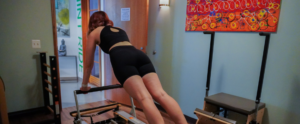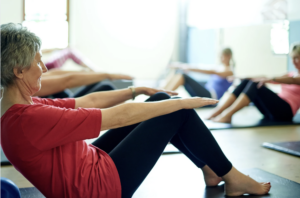Pigeon pose is the king of all hip openers, one of the most versatile and potent poses to address tension and improve range of motion in the hips and lower body. It is a fantastic pose to dive into more deeply if you are a regular yoga practitioner—it is likely already a part of your practice in some form. But pigeon is also a great tool to incorporate into your routine more generally as a way to release and lengthen after running, cycling, or other types of exercise. It is also an essential counter-pose for all of us who sit for long hours during the day. However, pigeon is a complex pose that requires poses to open and prepare the body, to ensure that the knees, hips and low back are safe as you explore this deep stretch.
the hips and lower body. It is a fantastic pose to dive into more deeply if you are a regular yoga practitioner—it is likely already a part of your practice in some form. But pigeon is also a great tool to incorporate into your routine more generally as a way to release and lengthen after running, cycling, or other types of exercise. It is also an essential counter-pose for all of us who sit for long hours during the day. However, pigeon is a complex pose that requires poses to open and prepare the body, to ensure that the knees, hips and low back are safe as you explore this deep stretch.
If you’ve never done pigeon before or if you have restricted movement in your hips or sacrum, or any knee injuries, start with the reclined version of pigeon pose on your back. To begin, lay on your back with knees bent, feet hip-width distance apart. Cross your right ankle over your left thigh, above the knee. Actively flex both feet then you can begin to draw your left knee towards your chest, threading your hands behind the left thigh. Make sure you continue to flex your right foot strongly to protect the knee joint and then gently press the right knee away from you to deepen the stretch in the outer right hip. Keep your head and shoulders releasing down to the mat to avoid creating tension in the neck. Do the other side.
When you’re ready to come into the full version of pigeon pose, start from table or downward facing dog. Bring your right knee forward to land slightly behind and to the right of your right wrist. Your shin can be diagonal or can come more parallel to the front of the mat depending on your flexibility. Engage the right foot to protect the knee joint. Then make sure your back leg is neutral, left outer thigh and outer hip rolling down into the mat. Actively lengthen the back leg down into the mat and lengthen up and out of the floor to elongate the left hip flexor and psoas muscles. If there is space between your right hip and the floor, place a block or folded blanket there for support. Breathe in the upright shape or begin to fold forward onto hands or forearms or rest onto a block in front of your front shin. Explore the other side—particularly with hip openers, you may find that the experience on one side of the body is different than the other.
In pigeon, as with all yoga poses, if you feel any pain or discomfort in your joints, back off and try a different variation. You may feel some intense sensation in this pose—make sure to keep breathing deeply!
Benefits of pigeon pose: Increases range of motion in hips, lengthens hip flexors, prepares body for backbends and seated poses, can reduce lower back pain associated with hip tension. Good counter pose for runners and cyclists as well as desk warriors—start with the reclined version if you haven’t practiced this pose before!
Contraindications: knee injury, sacrum instability or lower back injury.
We will be exploring variations on pigeon pose all month in our yoga classes. If you have questions or would like to dive deeper into your pigeon practice, talk to any of our MINT yoga instructors!
By: Kristin Adair





